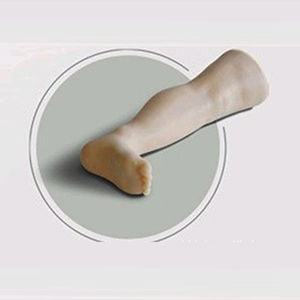Welcome to visitShanghai Chinon medical Model & Equipment Manufacturing Co., LTD
In medical education, bone piercing is a highly technical procedure that requires precise skill and experience. With the development of simulation medical technology, bone puncture model has become an indispensable tool in medical training. Industry experts agree that the bone puncture model significantly improves the practical skills of students and professionals through various applications, especially in terms of improving operational accuracy, reducing medical errors, and enhancing practical emergency response, which has great clinical significance.

1. Improve operation accuracy and confidence
The bone puncture model can simulate the real bone marrow puncture process and provide repeated operation opportunities for medical students and medical staff. Research data showed that participants who performed simulation training were able to reduce the rate of false puncture in real operations, and the success rate increased by about 30% (source: a journal of Medical Education). The use of the model enables students to familiarize themselves with the manipulation, depth, and Angle of bone puncture, practice repeatedly without patient risk, and gradually improve the accuracy and confidence of the procedure.
Through highly simulated models, students are able to experience every detail of the bone piercing process, from the selection of the piercing site to the use of the piercing tool, and even the adjustment of the patient's position, which are key factors affecting the success of the operation. The continuous repetition in the simulation training enables the trainees to firmly remember the operation skills in their minds and lay a solid foundation for future clinical work.
2. Reduces operational risk and improves clinical safety
There may be risks such as puncture failure and bleeding during bone puncture, especially in novice operation, and the error rate is high. Training with bone puncture models can effectively reduce risks in medical procedures. According to industry data, health care workers trained in simulation have a lower rate of complications during operations (source: Journal of Simulation Medicine). The bone piercing model provides a risk-free learning environment in which participants can fully practice piercing techniques and become familiar with handling unexpected situations without patient harm.
Experts pointed out that the feedback mechanism of the model can help students understand the problems in the operation in real time and avoid unnecessary mistakes. For example, the model can simulate the situation of improper selection of puncture site or wrong puncture Angle, and correct the trainees' operation in time to avoid these errors in real clinical situations.
3. Provide accurate feedback and self-assessment
The bone puncture model provides participants with a detailed analysis of the results of the operation through an integrated feedback mechanism and data collection system. This feedback helps students identify weaknesses in their own operations. According to industry experts, this feedback not only helps students adjust their operations in a timely manner, but also helps teachers and mentors assess students' learning progress and operational skills to further guide personalized learning.
For example, through simulation training, participants can receive data feedback on the success and failure of piercings, and know whether they have met the set operating standards. This data-driven approach to teaching makes the learning process more precise and efficient, and can provide students with suggestions for improvement, thereby improving the quality and effectiveness of learning.
4. Strengthen multidisciplinary cooperation and team training
In clinical practice, bone puncture procedures often involve the collaboration of multidisciplinary teams, including anesthesiologists, nurses, and physicians. Bone puncture models can also be used for training multidisciplinary teams to help team members improve their communication and collaboration skills. In simulation training, team members are able to work together to coordinate their responsibilities and tasks to ensure the smooth running of operations. Experts said that through the team training of the simulation model, the overall efficiency of the team can be significantly improved, and medical accidents caused by poor communication or operational errors can be reduced.
5. Accelerate learning and ensure continuous learning
The use of bone puncture models not only improves the learning speed of students, but also ensures their long-term effectiveness in actual clinical procedures. The traditional teaching model may slow the learning process due to various constraints (such as limited number of cases, few practical opportunities, etc.). The bone puncture model can provide more operational opportunities and greatly accelerate the learning progress of students. Experts pointed out that through multiple simulation operations, students can master the skills of bone piercing in a short time, thus improving the efficiency of education.
In addition, as medical technology and operating standards continue to be updated, bone puncture models can also be adjusted to new standards, ensuring that healthcare professionals can apply the latest techniques and methods in practice. Continuous simulation training helps students to strengthen their skills and ensure that they are able to cope with various complex situations they may encounter in the future.
Conclusion
As an important tool in medical education, bone puncture models have played an important role in improving practical skills. By providing precise operational training, feedback mechanisms, multidisciplinary collaboration, and continuous learning opportunities, the model effectively improves the skill level of the trainees, reduces medical errors, and improves the safety of clinical procedures. Industry experts generally believe that bone puncture model not only provides a new teaching method for medical education, but also provides a more reliable skill guarantee for clinical practice, and will continue to play an important role in the medical industry in the future